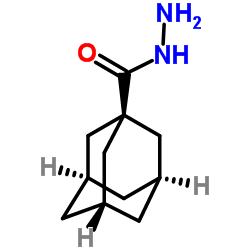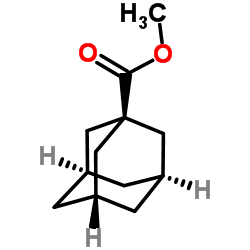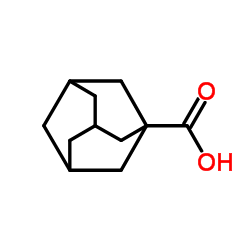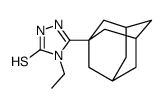17846-15-0
| Name | adamantane-1-carbohydrazide |
|---|---|
| Synonyms |
Tricyclo[3.3.1.1]decane-1-carboxylic acid, hydrazide
admantane-1-carbohydrazide 1-adamantanecarboxylic acid hydrazide 1-adamantanecarbohydrazide tricyclo[3.3.1.1~3,7~]decane-1-carbohydrazide F0020-1578 (3s,5s,7s)-1-Adamantanecarbohydrazide adamantane-1-carboxylic acid hydrazide adamantanecarbohydrazide adamantyl-1-carbohydrazide |
| Density | 1.2±0.1 g/cm3 |
|---|---|
| Boiling Point | 370.8±9.0 °C at 760 mmHg |
| Melting Point | 151ºC |
| Molecular Formula | C11H18N2O |
| Molecular Weight | 194.273 |
| Flash Point | 178.0±18.7 °C |
| Exact Mass | 194.141907 |
| PSA | 55.12000 |
| LogP | 1.25 |
| Vapour Pressure | 0.0±0.8 mmHg at 25°C |
| Index of Refraction | 1.581 |
Synonym: Section 2 - COMPOSITION, INFORMATION ON INGREDIENTS
Risk Phrases: 36/37/38 Section 3 - HAZARDS IDENTIFICATION EMERGENCY OVERVIEW
Irritating to eyes, respiratory system and skin. Potential Health Effects Eye: Causes eye irritation. Skin: Causes skin irritation. May be harmful if absorbed through the skin. Ingestion: May cause irritation of the digestive tract. May be harmful if swallowed. Inhalation: Causes respiratory tract irritation. May be harmful if inhaled. Chronic: Not available. Section 4 - FIRST AID MEASURES Eyes: Flush eyes with plenty of water for at least 15 minutes, occasionally lifting the upper and lower eyelids. Get medical aid. Skin: Get medical aid. Flush skin with plenty of water for at least 15 minutes while removing contaminated clothing and shoes. Ingestion: Get medical aid. Wash mouth out with water. Inhalation: Remove from exposure and move to fresh air immediately. If not breathing, give artificial respiration. If breathing is difficult, give oxygen. Get medical aid. Notes to Physician: Treat symptomatically and supportively. Section 5 - FIRE FIGHTING MEASURES General Information: As in any fire, wear a self-contained breathing apparatus in pressure-demand, MSHA/NIOSH (approved or equivalent), and full protective gear. Extinguishing Media: Use water spray, dry chemical, carbon dioxide, or chemical foam. Section 6 - ACCIDENTAL RELEASE MEASURES General Information: Use proper personal protective equipment as indicated in Section 8. Spills/Leaks: Vacuum or sweep up material and place into a suitable disposal container. Section 7 - HANDLING and STORAGE Handling: Avoid breathing dust, vapor, mist, or gas. Avoid contact with skin and eyes. Storage: Store in a cool, dry place. Store in a tightly closed container. Section 8 - EXPOSURE CONTROLS, PERSONAL PROTECTION Engineering Controls: Facilities storing or utilizing this material should be equipped with an eyewash facility and a safety shower. Use adequate ventilation to keep airborne concentrations low. Exposure Limits CAS# 17846-15-0: Personal Protective Equipment Eyes: Not available. Skin: Wear appropriate protective gloves to prevent skin exposure. Clothing: Wear appropriate protective clothing to prevent skin exposure. Respirators: Follow the OSHA respirator regulations found in 29 CFR 1910.134 or European Standard EN 149. Use a NIOSH/MSHA or European Standard EN 149 approved respirator if exposure limits are exceeded or if irritation or other symptoms are experienced. Section 9 - PHYSICAL AND CHEMICAL PROPERTIES Physical State: Solid Color: beige Odor: Not available. pH: Not available. Vapor Pressure: Not available. Viscosity: Not available. Boiling Point: Not available. Freezing/Melting Point: 157 deg C Autoignition Temperature: Not available. Flash Point: Not available. Explosion Limits, lower: Not available. Explosion Limits, upper: Not available. Decomposition Temperature: Solubility in water: Specific Gravity/Density: Molecular Formula: C11H18N2O Molecular Weight: 194 Section 10 - STABILITY AND REACTIVITY Chemical Stability: Not available. Conditions to Avoid: Incompatible materials. Incompatibilities with Other Materials: Strong oxidizing agents, acids, acid chlorides. Hazardous Decomposition Products: Carbon monoxide, oxides of nitrogen, carbon dioxide. Hazardous Polymerization: Has not been reported Section 11 - TOXICOLOGICAL INFORMATION RTECS#: CAS# 17846-15-0 unlisted. LD50/LC50: Not available. Carcinogenicity: Adamantane-1-carbohydrazide - Not listed by ACGIH, IARC, or NTP. Section 12 - ECOLOGICAL INFORMATION Section 13 - DISPOSAL CONSIDERATIONS Dispose of in a manner consistent with federal, state, and local regulations. Section 14 - TRANSPORT INFORMATION IATA No information available. IMO No information available. RID/ADR No information available. Section 15 - REGULATORY INFORMATION European/International Regulations European Labeling in Accordance with EC Directives Hazard Symbols: XI Risk Phrases: R 36/37/38 Irritating to eyes, respiratory system and skin. Safety Phrases: S 26 In case of contact with eyes, rinse immediately with plenty of water and seek medical advice. S 37/39 Wear suitable gloves and eye/face protection. WGK (Water Danger/Protection) CAS# 17846-15-0: No information available. Canada None of the chemicals in this product are listed on the DSL/NDSL list. CAS# 17846-15-0 is not listed on Canada's Ingredient Disclosure List. US FEDERAL TSCA CAS# 17846-15-0 is not listed on the TSCA inventory. It is for research and development use only. SECTION 16 - ADDITIONAL INFORMATION N/A |
| Hazard Codes | Xi:Irritant; |
|---|---|
| Risk Phrases | R36/37/38 |
| Safety Phrases | S26-S37/39 |
| HS Code | 2928000090 |
|
~23% 
17846-15-0 |
| Literature: Russian Journal of Organic Chemistry, , vol. 44, # 12 p. 1760 - 1764 |
|
~% 
17846-15-0 |
| Literature: Molecules, , vol. 15, # 4 p. 2526 - 2550 |
|
~% 
17846-15-0 |
| Literature: Chemische Berichte, , vol. 93, p. 1161 - 1166 |
|
~% 
17846-15-0 |
| Literature: European Journal of Medicinal Chemistry, , vol. 68, p. 96 - 102 |
| Precursor 3 | |
|---|---|
| DownStream 5 | |
| HS Code | 2928000090 |
|---|---|
| Summary | 2928000090 other organic derivatives of hydrazine or of hydroxylamine VAT:17.0% Tax rebate rate:9.0% Supervision conditions:none MFN tariff:6.5% General tariff:20.0% |






![5-Adamantan-1-yl-4-allyl-4H-[1,2,4]triazole-3-thiol structure](https://image.chemsrc.com/caspic/057/345987-96-4.png)

![5-ADAMANTAN-1-YL-[1,3,4]THIADIAZOL-2-YLAMINE structure](https://image.chemsrc.com/caspic/309/26526-57-8.png)
